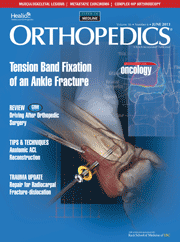
ARTHROPLASTY
CT-assessed 3D alignment of PSI vs. conventional instrumentation in TKA
Orthopedics. 2015 Apr 1;38(4):e271-8030 patients scheduled for total knee arthroplasty (TKA) were randomized to one of two groups: one group underwent the procedure with the use of patient-specific instrumentation (PSI), and the other with conventional instrumentation. The purpose of this study was to determine whether the use of PSI in TKA led to significantly improved CT alignment of components in the coronal, sagittal, and axial planes. Overall, postoperative alignment appeared similar between groups, with a maximum of one patient from either group considered an outlier in any of the three planes of alignment.
Unlock the full ACE Report
You have access to {0} free articles per month.Click below to unlock and view this {1}
Unlock NowCritical appraisals of the latest, high-impact randomized controlled trials and systematic reviews in orthopaedics
Access to OrthoEvidence podcast content, including collaborations with the Journal of Bone and Joint Surgery, interviews with internationally recognized surgeons, and roundtable discussions on orthopaedic news and topics
Subscription to The Pulse, a twice-weekly evidence-based newsletter designed to help you make better clinical decisions
Exclusive access to original content articles, including in-house systematic reviews, and articles on health research methods and hot orthopaedic topics
Or upgrade today and gain access to all OrthoEvidence content for just $1.99 per week.
Already have an account? Log in


Subscribe to "The Pulse"
Evidence-Based Orthopaedics direct to your inbox.
{0} of {1} free articles
Become an OrthoEvidence Premium Member. Expand your perspective with high-quality evidence.
Upgrade Now












































































